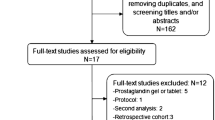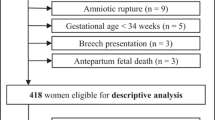Abstract
Purpose
To compare a double-balloon catheter and dinoprostone vaginal insert for induction of labor with an unfavorable cervix.
Methods
Patients with a Bishop score of ≤6 requiring labor induction at term received either a double-balloon catheter or a dinoprostone vaginal insert. The primary outcome was vaginal delivery rate within 24 h, and the secondary outcome was cesarean section rate.
Results
A total of 155 women were included; 76 received induction with a double-balloon catheter and 79 with the dinoprostone vaginal insert. The groups were similar with respect to maternal age, body mass index, gravidity, parity, baseline Bishop score, and indications for induction. Gestational age at induction was similar between the groups (double balloon 40.52 ± 0.86 weeks; dinoprostone 40.60 ± 0.79 weeks, P = 0.516). There was no difference in the vaginal delivery rate within 24 h (50 vs. 53.2 %, P = 0.694) or the cesarean section rate (39.5 vs. 31.6 %, P = 0.185) between the groups. More patients in the double-balloon catheter group required oxytocin administration than in the dinoprostone group (75 vs. 31.65 %, respectively, P < 0.001), but uterine hyperstimulation was less frequent in the double-balloon catheter group (0 vs. 10.1 %, respectively, P = 0.007). Neonatal outcomes were similar between the groups.
Conclusion
Double-balloon catheter and dinoprostone vaginal insert are associated with similar vaginal delivery and cesarean section rates and neonatal outcomes.
Similar content being viewed by others
References
Swamy GK (2012) Current methods of labor induction. Semin Perinatol 36:348–352
Hawkins JS, Wing DA (2012) Current pharmacotherapy options for labor induction. Expert Opin Pharmacother 13:2005–2014
Gelber S, Sciscione A (2006) Mechanical methods of cervical ripening and labor induction. Clin Obstet Gynecol 49:642–657
Pennell CE, Henderson JJ, O’Neill MJ, McChlery S, Doherty DA, Dickinson JE (2009) Induction of labour in nulliparous women with an unfavourable cervix: a randomised controlled trial comparing double and single balloon catheters and PGE2 gel. BJOG 116:1443–1452
Cromi A, Ghezzi F, Agosti M, Serati M, Uccella S, Arlant V, Bolis P (2011) Is transcervical Foley catheter actually slower than prostaglandins in ripening the cervix? A randomized study. Am J Obstet Gynecol 204:338.e1–338.e7
Jozwiak M, Oude RK, Benthem M et al (2011) Foley catheter versus vaginal prostaglandin E2 gel for induction of labour at term (PROBAAT trial): an open-label, randomised controlled trial. Lancet 378:2095–2103
Adeniji OA, Oladokun A, Olayemi O, Adeniji OI, Odukogbe AA, Ogunbode O, Aimakhu CO, Omigbodun AO, Ilesanmi AO (2005) Pre-induction cervical ripening: transcervical foley catheter versus intravaginal misoprostol. J Obstet Gynaecol 25:134–139
Carbone JF, Tuuli MG, Fogertey PJ, Roehl KA, Macones GA (2013) Combination of Foley bulb and vaginal misoprostol compared with vaginal misoprostol alone for cervical ripening and labor induction: a randomized controlled trial. Obstet Gynecol 121:247–252
Kehl S, Ehard A, Berlit S, Spaich S, Sütterlin M, Siemer J (2011) Combination of misoprostol and mechanical dilation for induction of labour: a randomized controlled trial. Eur J Obstet Gynecol Reprod Biol 159:315–319
Cromi A, Ghezzi F, Uccella S, Agosti M, Serati M, Marchitelli G, Bolis P (2012) A randomized trial of preinduction cervical ripening: dinoprostone vaginal insert versus double-balloon catheter. Am J Obstet Gynecol 207:121–125
Salim R, Zafran N, Nachum Z, Garmi G, Kraiem N, Shalev E (2011) Single-balloon compared with double-balloon catheters for induction of labor: a randomized controlled trial. Obstet Gynecol 118:79–86
Atad J, Hallak M, Ben-David Y, Auslender R, Abramovici H (1997) Ripening and dilatation of the unfavourable cervix for induction of labour by a double balloon device: experience with 250 cases. Br J Obstet Gynaecol 104:29–32
Rutherford SE, Phelan JP, Smith CV, Jacobs N (1987) The four-quadrant assessment of amniotic fluid volume: an adjunct to antepartum fetal heart rate testing. Obstet Gynecol 70:353–356
Hadlock FP, Deter RL, Harrist RB, Park SK (1984) Estimating fetal age: computer-assisted analysis of multiple fetal growth parameters. Radiology 152:497–501
Halaska MG, Vlk R, Feldmar P, Hrehorcak M, Krcmar M, Mlcochova H, Mala I, Rob L (2006) Predicting term birth weight using ultrasound and maternal characteristics. Eur J Obstet Gynecol Reprod Biol 128:231–235
(2008) Obstetrics and Gynecology. In: Jie LE (ed) 7th edn. People’s Medical Publishing House, Beijing
ACOG Committee on Practice Bulletins—Obstetrics (2009) ACOG Practice Bulletin No. 107: induction of labor. Obstet Gynecol 114:386–397
Lee KA, Mi Lee S, Jin Yang H, Park CW, Mazaki-Tovi S, Hyun Yoon B, Romero R (2011) The frequency of meconium-stained amniotic fluid increases as a function of the duration of labor. J Matern Fetal Neonatal Med 24:880–885
Caughey AB, Sundaram V, Kaimal AJ et al (2009) Systematic review: elective induction of labor versus expectant management of pregnancy. Ann Intern Med 151:252–263
Osava RH, Silva FM, Vasconcellos de Oliveira SM, Tuesta EF, Amaral MC (2012) Meconium-stained amniotic fluid and maternal and neonatal factors associated. Rev Saude Publica 46:1023–1029 (Article in Portuguese)
Tathem K, Harris LJ, O’Rourke P, Kimble RM (2012) Dinoprostone vaginal pessary for induction of labour: safety of use for up to 24 h. Aust NZJ Obstet Gynaecol 52:582–587
Acknowledgments
The study was funded by Science and technology plan of social development projects of Guangdong Province (No. 2010B080701011) and National Natural Science Foundation of China (No. 81470067). There was no commercial financial support of this study.
Conflict of interest
None.
Author information
Authors and Affiliations
Corresponding author
Additional information
Chuying Du and Yukun Liu contributed equally to this manuscript.
Rights and permissions
About this article
Cite this article
Du, C., Liu, Y., Liu, Y. et al. Double-balloon catheter vs. dinoprostone vaginal insert for induction of labor with an unfavorable cervix. Arch Gynecol Obstet 291, 1221–1227 (2015). https://doi.org/10.1007/s00404-014-3547-3
Received:
Accepted:
Published:
Issue Date:
DOI: https://doi.org/10.1007/s00404-014-3547-3




